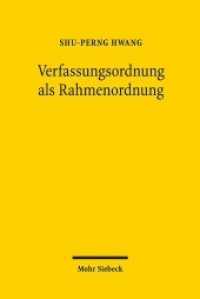- ホーム
- > 洋書
- > ドイツ書
- > Humanities, Arts & Music
- > Music
- > theory of music & music basics
Description
(Short description)
Encouraging the exploration of creativity in the unfettered environment of the chromatic-modal system and asymmetric form. Free from conventional harmonic patterns, this approach clears the way for expression in any style: post-50s jazz, ECM, fusion, pop, classical.
(Text)
The goal of this book is to show the student the means to develop latent creative abilities by offering the unfettered environment of the chromatic-modal system and free asymmetric form. The freedom of the approach will allow the composer to express him/herself in any style: post 50s jazz, ECM, fusion, pop, classical, etc., that is not tied to any harmonic particulars.Ron Miller is professor of jazz studies at the University of Miami. His compositions have been recorded and/or performed by notable musicians as Red Rodney, "Elements", Jerry Coker, Ira Sullivan and Stan Getz. Composition students of Ron Miller that have attained notoriety include: Pat Metheny, Steve Morse, "T" Lavitz, Bruce Hornsby, Gil Goldstein, Mark Egan, Matt Harris, Denis DiBlasio and Rick Margitza.
(Table of content)
Introduction - A Jazz Composer's Regimen - How To Use This Book - Categories of Jazz Compositions - Chapter I: Jazz Harmonic Systems - Chapter II: Constructions of the Unaltered Diatonic Modes - Chapter III: Construction of the Unaltered Diatonic Chords - Chapter IV: Characteristics of the Unaltered Diatonic Modes - Chapter V: The Modes of the Altered Diatonic No. 1 (Melodic Minor) - Chapter VI: Non-Modal Chords - Chapter VII: Chord Connection / Compositional Devices - Chapter VIII: Upper Structures - Chapter IX: Completing the Chord Connection Process - Chapter X: Form - Chapter XI: Harmonic Contour - Chapter XII: The Modes and Chords of the Altered Diatonic No. 2 (Harmonic Minor) - Chapter XIII: Slash Chord Harmony - Chapter XIV: Three-Part Upper Structure Chords - Chapter XV: The Chords of the Altered Diatonic No. 3 (Harmonic Major) and Altered Diatonic No. 4 (Melodic Minor #5) - Conclusion and Final Comments for Volume 1 - Appendix
(Short description)
Encouraging the exploration of creativity in the unfettered environment of the chromatic-modal system and asymmetric form. Free from conventional harmonic patterns, this approach clears the way for expression in any style: post-50s jazz, ECM, fusion, pop, classical.
(Text)
The goal of this book is to show the student the means to develop latent creative abilities by offering the unfettered environment of the chromatic-modal system and free asymmetric form. The freedom of the approach will allow the composer to express him/herself in any style: post 50s jazz, ECM, fusion, pop, classical, etc., that is not tied to any harmonic particulars.Ron Miller is professor of jazz studies at the University of Miami. His compositions have been recorded and/or performed by notable musicians as Red Rodney, "Elements", Jerry Coker, Ira Sullivan and Stan Getz. Composition students of Ron Miller that have attained notoriety include: Pat Metheny, Steve Morse, "T" Lavitz, Bruce Hornsby, Gil Goldstein, Mark Egan, Matt Harris, Denis DiBlasio and Rick Margitza.








